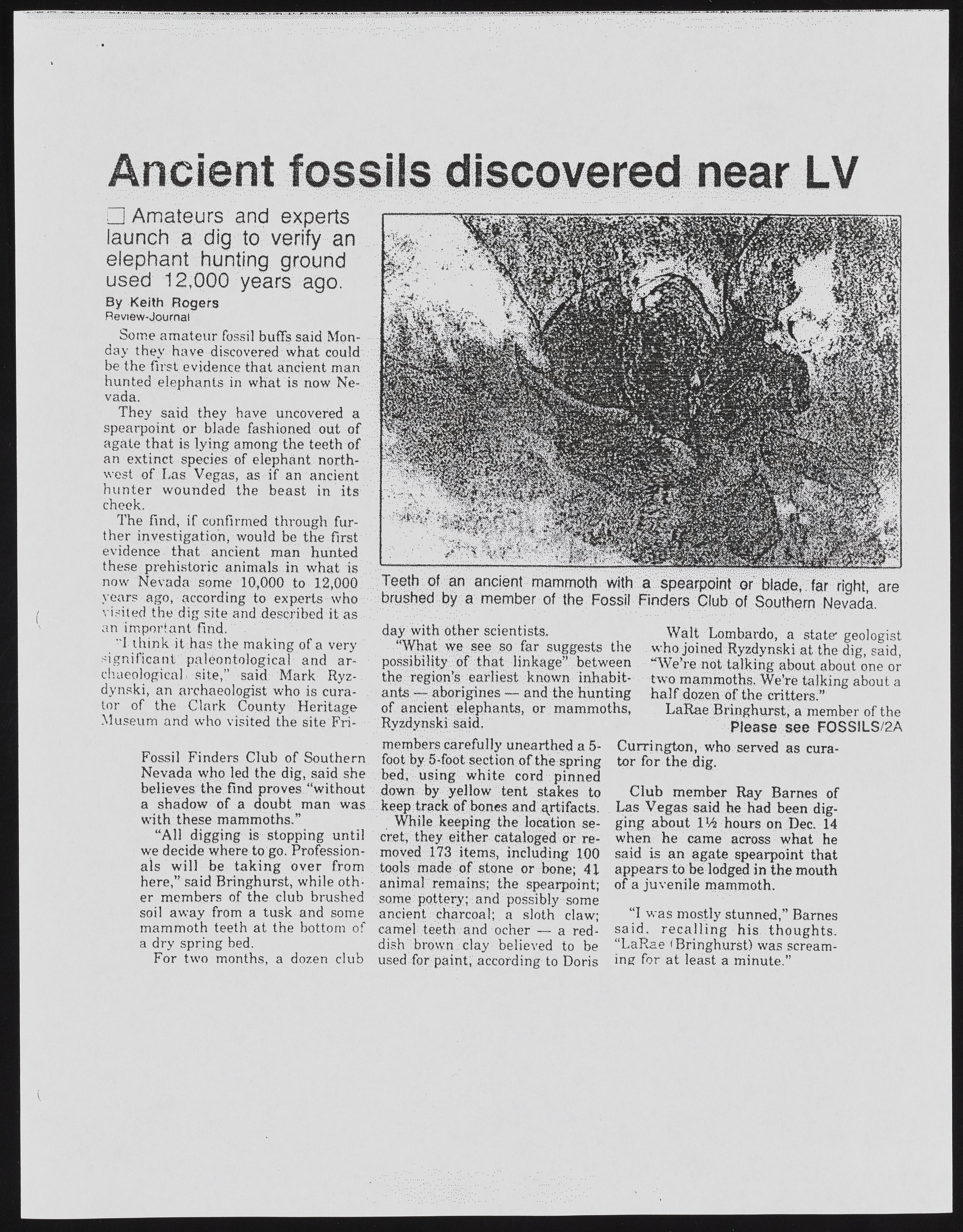Copyright & Fair-use Agreement
UNLV Special Collections provides copies of materials to facilitate private study, scholarship, or research. Material not in the public domain may be used according to fair use of copyrighted materials as defined by copyright law. Please cite us.
Please note that UNLV may not own the copyright to these materials and cannot provide permission to publish or distribute materials when UNLV is not the copyright holder. The user is solely responsible for determining the copyright status of materials and obtaining permission to use material from the copyright holder and for determining whether any permissions relating to any other rights are necessary for the intended use, and for obtaining all required permissions beyond that allowed by fair use.
Read more about our reproduction and use policy.
I agree.Information
Digital ID
Permalink
Details
More Info
Rights
Digital Provenance
Publisher
Transcription
Ancient fossils discovered near LV ? Amateurs and experts launch a dig to verify an used 12,000 years ago. By Keith Rogers Review-Journal Some amateur fossil buffs said Monday they ? have discovered ? what could . be the first evidence that ancient man hunted; elephants in what is' now Ne* : vada, They said they have uncovered a spearpoint or blade fashioned out of agate that is lying among the teeth of an extinct species of elephant north-west- of ;Las. Vegas, as-if an ancient hunter wounded the beast in its cheek. The find, if confirmed through further investigation, would be the first 'evidence ?' that-. • ancient man ? ? hunted th^se prehistoric animals in what is now Nevada some 10,000 to 12,000 years ago, according to experts who visited the'dig site anddescribed it as - an important find, ‘1 think it has the making of a very significant paleontological and archaeological; -site/.' • said:? Mark"'Ryz-. dynski, an archaeologist who is curator of the Clark County Heritage Museum and who visited the site§Pri- Fossil Finders Club of Southern Nevada who led the dig, said she believes the find proves., “without a shadow of a doubt man was M th' t|iese mammothsC “All digging is stopping until we decide where to go. Professionals will be taking over from here,'? said Rringhurst, while other mem hers of the club brushed soil away from a tusk and some mammoth teeth at the bottom of Teeth of an ancient mammoth with a ' ^ r ::t>iad!e*: ar? right are brushed by a member of the Fossil Finders Club of Southern Nevada. a ary spring For two months, a dozen club day with other scien||sts,. • •<fiiVhat:;wo;;see so'far suggests the possibilitydfthatlinkage''betw een the region^ earliest known inhabitants — aborigines -—‘ and the hunting of ancient elephants, or mammoths, ; Ryzdynski said.' members carefully unearthed a 5- foot by 5 -foot sect ion of the sp.ri ng bed, using white cord pinned down by yellow tent stakes to : keeptrackofbones .and''artifacts, While keeping the location secret, they either cataloged'' or .'removed 173 items, including 100 • 41 animal remains; the spearpoint; some pottery; and possibly some ancient charcoal; a sloth claw; camel teeth and ocher — a reddish brown clay believed to be used for paint, according to Doris Walt Lombardo, a state geologist who joined Ryzdynski at the dig, said, “'We're not talking about about one or two m am pths, We’re talking about a half dozen of the cri LaRae Bringhurst, a member of the ' ? Ptea$a ; see FQSSILS/2A Currington, who served as curator for the dig. Club member Ray Barnes of Las Vegas said he had been digging about 1 Vi hours on Dec. 14 when he came across what he said is an agate spearpoint that appears to be lodged in the mouth of a juvenile mammoth. “I was mostly stunned,” Barnes said, recalling his thoughts. “LaRae^ Bringhurst) was screaming for at least a minute.”

